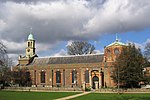St Luke's Church, Kew
1889 establishments in England19th-century Church of England church buildingsAnglican Diocese of SouthwarkChurch of England church buildings in the London Borough of Richmond upon ThamesChurches completed in 1889 ... and 5 more
Churches in KewCommunity centres in LondonGothic Revival church buildings in LondonSocial centres in the United KingdomUse British English from June 2015

St Luke's Church, Kew, is a parish church in Kew, in the London Borough of Richmond upon Thames. It is part of the Church of England and the Anglican Communion and, locally, is a member of Churches Together in Kew. Together with St Philip and All Saints (the Barn Church), it is one of two parishes within the united benefice of Kew, St Philip & All Saints with St Luke. Its vicar, Rev Dr Melanie Harrington, took up the role in June 2021. The church, built in the Gothic Revival style by architects Goldie, Child and Goldie, is also host to the Kew Community Trust and acts as a community centre.
Excerpt from the Wikipedia article St Luke's Church, Kew (License: CC BY-SA 3.0, Authors, Images).St Luke's Church, Kew
The Avenue, London North Sheen (London Borough of Richmond upon Thames)
Geographical coordinates (GPS) Address External links Nearby Places Show on map
Geographical coordinates (GPS)
| Latitude | Longitude |
|---|---|
| N 51.4739 ° | E -0.2891 ° |
Address
St. Luke's Parish Church and Community Centre
The Avenue
TW9 2AJ London, North Sheen (London Borough of Richmond upon Thames)
England, United Kingdom
Open on Google Maps








